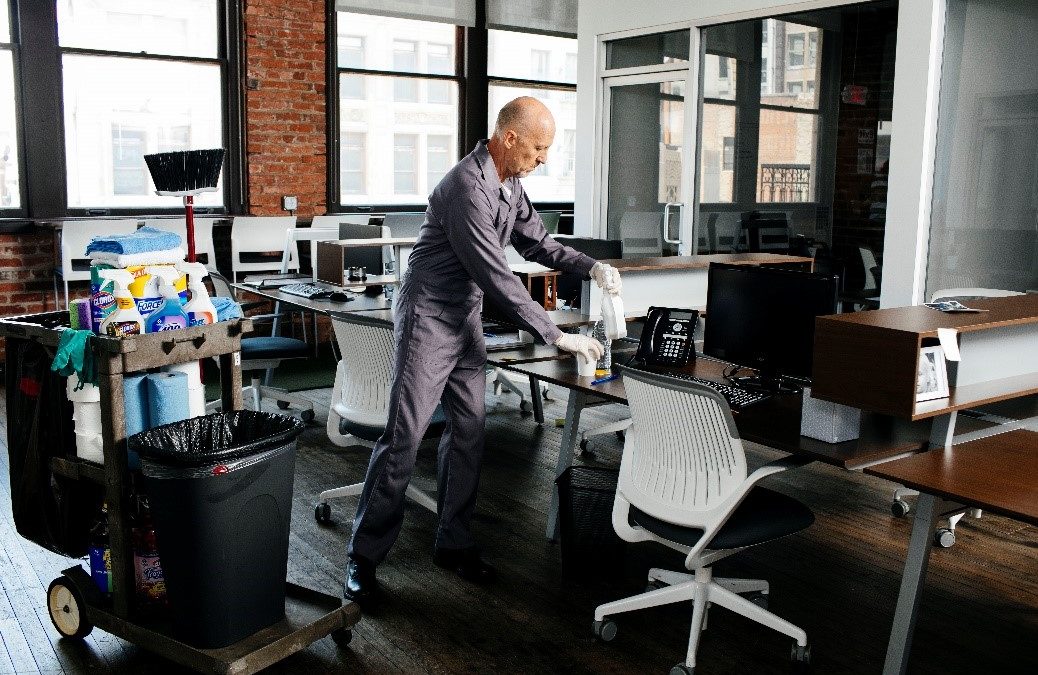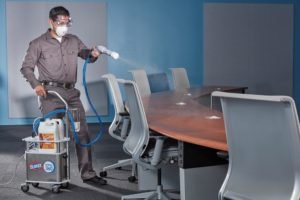
by Brad Ferris
Flu viruses are spread from person to person through the air, mainly by droplets that are expelled when people with the flu cough and sneeze. Flu viruses also can spread via contaminated surfaces, when someone touches a surface or object that has flu virus on it and then touches their mouth, nose or eyes.
During flu season, office settings can present a perfect storm of environmental risk factors and behaviors conducive to outbreaks with a high number of people in enclosed areas, sharing the same spaces.
Vaccinations and maintaining healthy habits like proper handwashing, covering your cough and staying home when sick are important flu prevention measures but really depend on the building occupants themselves. Facility managers should encourage these behaviors but also plan to step up their surface-disinfection game to help reduce the risk of germs spreading via contaminated surfaces.
Stepping up your surface disinfection
Surface disinfection is always important because commonly touched surfaces like elevator buttons, door handles, light switches and countertops can harbor illness-causing germs, some of which can survive on surfaces for extended periods. Influenza viruses can survive on hard surfaces like stainless steel and plastic for up to 48 hours.[1] Norovirus, another important illness to look out for during winter months, can also persist on surfaces for days.[2]
To help reduce the risk of flu and other common illnesses spreading in offices, it is important to clean and disinfect surfaces daily. Objects and surfaces such as desks, countertops, doorknobs, keyboards, faucets, phones and elevator buttons can yield a high number of germs due to how frequently they are touched and should always be disinfected thoroughly with an EPA-registered disinfectant on a routine basis.
Picking the right tools
To be effective, facility managers need to ensure that cleaning crews have the right tools for the job and know how to use them correctly. During flu season, it is important to make sure the disinfectants being used have EPA-registered claims to kill viruses like influenza and rhinovirus, the leading cause of the common cold, quickly. It is also important to ensure that cleaning professionals know how to use the product correctly and refer to the product label and manufacturer’s instructions for use and contact time, or the length of time the disinfectant needs to remain wet on the surface to effectively kill germs.
Ready-to-use products and disinfecting wipes are good options for disinfecting high-touch surfaces because they are easy to use, require no dilution and deliver the proper chemical concentration every time they are used, minimizing the risk of human error.
For large spaces and hard-to-reach places, time-saving electrostatic spraying systems such as the Clorox Total 360 System are a great option to promote efficiency and improve coverage. The Clorox Total 360 System combines proven electrostatic technology with trusted disinfecting products to quickly and easily provide superior surface coverage via an electrostatic sprayer, evenly coating all surfaces and hard-to-reach areas where germs could hide.
Remember, the best offense is a good defense and consistent cleaning and disinfecting practices using appropriate EPA-registered products can go a long way to help keep commercial facilities clean and healthy during flu season and all year long. To learn more about flu season infection prevention visit www.CloroxPro.com.
Brad Ferris is the Brand Engagement Lead and public relations representative for CloroxPro.
[1] “Interim Guidance on Environmental Management of Pandemic Influenza Virus.” Flu.gov. Retrieved from: http://www.flu.gov/planning-preparedness/hospital/influenzaguidance.html. (Accessed Feb. 13, 2019).
[2] Hall, A. “Norovirus disease in the United States.” Emerging Infectious Diseases. 19.8 (2013). (Accessed Feb. 13, 2019).


